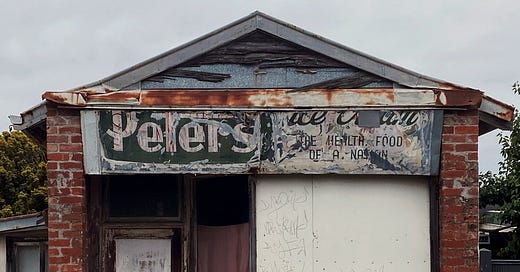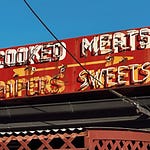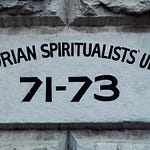Along the dusty edge of the Nepean Highway, where Melbourne melts into sea spray and congested holiday traffic, there’s a dead milk bar that once served the locals and folks on holiday in the sunburnt haze of Melbourne’s past. Now it just wheezes into the sea breeze. A brick husk. A faded temple to ice cream and the feeling of endless summer.

I’ve photographed hundreds of ghost signs. But this one? This one haunted its way into the exhibition. Not because it’s grand. But because it just vibes different.
There’s a Peter’s Ice Cream sign clinging to the façade like an old campaign sticker for a lost cause — “Health Food of a Nation,” it pleads, from a time when dairy was a religion and a frozen block of milk and sugar could fix just about anything. Tired kids. Failing marriages. The sting of salt on blistered backs.
But peel it back — literally — and you’ll see something older, stranger, sadder: a sign for Sennitt’s Ice Cream, a brand now buried deep in the Australian unconscious, right next to Sunnyboys and mixed lollies in crinkly white paper bags.
If you were around in the ‘50s, you might remember the neon polar bear. Towering next to the Allen’s Sweets sign, licking an ice cream in technicolour. Sennitt’s mascot glowed like a radioactive totem from their Southbank factory rooftop. Then, one day, it was gone. Demolished. Like it had never been there. No plaque. No goodbye.
The story of Sennitt’s begins in the 1890s, with a man named John Paul Sennitt — a refrigeration engineer turned frozen visionary. Before Streets. Before Peter’s. Before global ice cream brands gobbled it all up, there was Sennitt’s: Melbourne-made, polar bear-approved.
And here, at this milk bar — half shop, half sarcophagus — the story lingers.
The door still bears a ghost sign for National Mutual Fire Insurance Company, because even back then, they knew this dream could go up in flames. The awning’s long gone, just the skeletal wooden “ribs” remain, like the bones of a thing that once breathed in hot summer air and exhaled cool relief in a waffle cone.
Seaford itself wasn’t even a place until the railway named it in 1913. It was the overlooked cousin of Frankston — fewer crowds, more dunes, and just enough locals to need a shop slinging smokes, milk, and melting desserts.
This place is more than a ruin. It’s a mirage. A Kodachrome postcard from a childhood you’re not even sure was yours. The sweet drip of a Sennitt’s cone down your wrist. The rattle of a flyscreen door. Bare feet on sand. A beach towel stiff with salt.
Now it just sits. Watching traffic. Holding its breath. Waiting for someone to remember.














Share this post